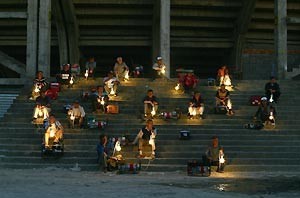
Adrian Paci, Turn On, 2003 © Adrian Paci
The 1st at Moderna: Adrian Paci
Turn On
1.1 2005 – 27.2 2005
Stockholm
From a lingering, almost aloof camera movement in daylight, there is an abrupt shift to darkness. An almost effulgent light, a sacral saturation, dissolves into blackness, and then, suddenly, let there be light! Generators appear, ancient, mechanical things, with which the men, one by one, turn on large light bulbs that they hold in front of them like torches.
Adrian Paci, born in 1969 into an artist family, was educated at the Academy of Art in Albania before the fall of the totalitarian regime. From having worked in a realistic tradition, it was suddenly possible to experiment with new attitudes. It was a time of breakup and chaos, during which Adrian Paci escaped to Italy with his family. Albanian Stories (1997) was his first work after the emigration. His daughter, Yolanda, then three years old, relates memories and reenacts a tale featuring a cat and a rooster, the evil powers and the international forces. The depth of the story moved Adrian Paci; it did not need any artistic adaptation other than that which a simple video camera could provide. His role as an artist was suddenly subordinated to the fundamentals of his child’s serious game. Apparizione (2001) is a video work in the same spirit, in which his youngest daughter, Tea, is singing in Italy while her relatives in Albania ‘answer’. Like an antiphony, a liturgy of exile and loss, the song flows back and forth. Particularly in his early works, Adrian Paci is inspired by his own experiences. The specificity gradually assumes a more general form, his own life becoming part of the collective history.
Adrian Paci does not shy away from the seemingly banal. With a slightly twisted humour, he tackles major existential and societal issues which he chooses to express in an apposite form. An example is his participation in the group exhibition, Tillsammans (Together), with Swedish, Cuban and Albanian artists, in conjunction with the Tirana Biennial 2003. An open email discussion was the point of departure for the project; all the participating artists had experienced various forms of socialism.
The Swedish Institute provided some funding but could only do so for the Swedish artists. Adrian Paci created an installation with generators, which is a common feature of Albanian daily life, where power cuts occur at least a few times a day. He provided energy for the Swedish artworks during the frequent power cuts on condition that the Swedes paid for it – a national contribution set into circulation.
The pain of exile is seldom far away in Adrian Pace’s work. In Vajtojca (2002), he stages his own death ritual. A professional mourner laments in rhythmic verse over his bed where he lies motionless dressed soberly in black and white. The wish of a verse is fulfilled; he sits up and embraces the mourner, a grand and slapsticklike finale. On the other side of the wall is his mother, in utter despair, the son has emigrated, he is gone for ever.
In Back Home (1999) he creates a portrait of some of his Albanian friends who, having left everything behind, have now achieved some measure of success in their new lives. Adrian Paci was granted access to their abandoned homes in Albania, which he photographed and painted. These paintings form the backdrop in front of which the emigrated Albanians pose in their new environments. The further away from reality one is, the more present the symbolism seems.
After the Wall There are Some Walls (2001), an impenetrable wall made of waterfilled plastic containers, is a work where Adrian Paci has expanded the notions of symbolism and realism. He went out on the Adriatic Sea, to the Otranto Straits, the scene of so much hope and despair on the border between the poor and the rich. He collected water in plastic containers and was stopped by a police patrol, his identity as an Albanian and as an artist was called into question. In his attempt to convince the police of the plausibility of this unnatural act, he offered them a text to read. Instead, the police officer looked at his boat, discovered that it was acquaintance’s vessel and let Adrian Paci off the hook.
In Turn On, the work shown within the framework of the 1st at Moderna, there is – as in the wall of waterfilled plastic containers – an undercurrent of mild gallows humour, but more subdued, qui-eter. Instead, painterly qualities appear; this is a celebration of people who rise above the shortcomings of society. From the gloominess of unemployment, from the depths of the eternal waiting, hope emerges through the buzzing of a gener-ator, or, perhaps, a glimpse of dissociated irony over a society in decline, for which people are to blame while they simulta-neously transcend it. A hope, if subdued, for the coming.
Adrian Paci
Born in 1969 in Shkoder, Albania. Lives and works in Milan, Italy. Educated at the Academy of Art, Tirana, Albania.
Latest selected solo exhibitions
2004
Galleria Francesca Kaufmann, Milan
Viafarini, Milano
2003
Baltic Art Center, Visby, Sweden
Galerie Peter Kilchmann, Zürich
Latest selected group exhibitions
2004
New Video, New Europe, Renaissance Society, Chicago (curator Hamza Walzer, touring exhibition to, among other venues, Tate Modern)
Biennale di Centinje, Montenegro (curator René Block)
Sevilla Biennale, Spain (curator Harald Szeemann)
Dimensione Follia, Galleria Civica di Trento, Italy (curator Roberto Pinto)
Curator: Ann-Sofi Noring
The 1st at Moderna is an exhibition programme for contemporary art. The opening is always on the first day of the month, and the exhibitions are in different venues in or outside the museum.
